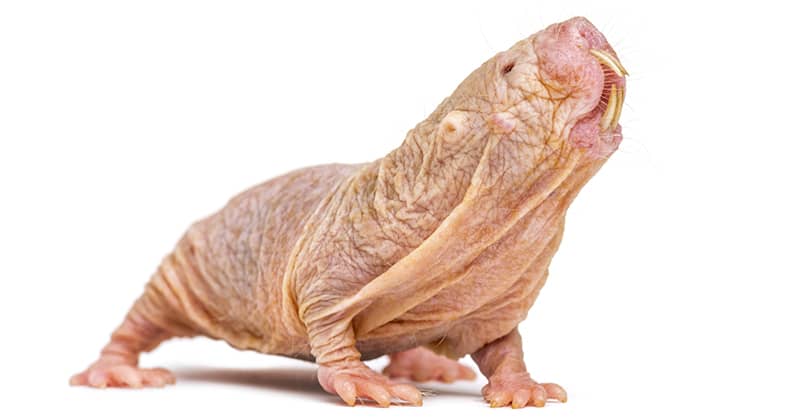
The naked mole rat can hardly be described as cute. With its large buck teeth and wrinkled, hairless body, this small, sausage-shaped rodent wouldn’t win any prizes in a beauty contest. Yet for scientists, this creature is a star attraction.
That’s because it lives more than ten times longer than other rodents, barely ages, and is largely impervious to age-related diseases like cancer. Discovering the reasons for its eternal youth could be key to stopping human diseases and even aging. Scientists recently began unraveling the mystery of the naked mole rat’s longevity. Here’s what they know so far…
Naked mole rats are truly a miracle of nature. These funny-looking little rodents can live for over 40 years, almost never suffer heart disease, neurodegeneration, deteriorating bone quality, arthritis, or cancer. In fact, studies show they’re basically impervious to some types of pain and remain fit and active for almost their entire lives. What’s more, these creatures can withstand long periods of time without oxygen and have a strong circadian rhythm even though they lack exposure to the sun.
Naked mole rats live in large underground colonies in Africa where, like ant colonies, only the queen is fertile and, remarkably, can breed right through to old age, giving birth to up to 900 pups during her lifetime!
The naked mole rat’s long and disease-free life has been a puzzle to scientists, but a research team at the University of Rochester, New York, led by distinguished geroscientist Vera Gorbunova, has made some important discoveries.
Unique anti-cancer mechanisms
The Rochester group has uncovered several reasons why the naked mole rat doesn’t get cancer.
The first is because it has an extra cancer-fighting protein not found in mice or humans. The protein is linked to a cluster of genes called the INK4 gene locus.
“Considering how mutations in the INK4 gene are linked to human cancers,” said Professor Gorbunova, “the better we understand that gene and control its mutations, the better our chances of controlling some cancers.”
Another reason is that the creature expresses a gene called p16 that makes cells "claustrophobic". When too many cells crowd together, a powerful anticancer mechanism called early contact inhibition stops cell growth. The mechanism is lost in cancer cells, so they keep growing.
Prof. Gorbunova believes that “if the effect of p16 can be simulated in humans we might have a way to halt cancer before it starts."
But before this could be accomplished, the scientific team needed to find out what induces the expression of p16. They discovered the answer back in 2013. It’s a special form of the long sugar polymer, hyaluronic acid (HA). HA is long praised in anti-aging medicine for its ability to support younger-looking skin and healthy joints. This special form of HA is the substance that’s behind the prevention of cellular overcrowding and tumor formation in the naked mole rat.
What would happen if this special form of HA was transferred to mice? Would they become cancer-free and live longer?
Better health – longer life
HA (or hyaluronan) is an important moisture-containing component of the extracellular matrix, joints, eyes, and skin. It also has important cell signaling and regulatory functions. It’s used in the treatment of arthritis and is found in anti-wrinkle skin care products.
An important fact about HA that you may not realize is that it comes in a range of molecular weights-- and in this case size matters! That’s because the high mass version is anti-inflammatory whereas the low mass version is pro-inflammatory and has been linked to the spread of cancer.
Back to the naked mole rat…
HA super sugar makes them cancer-proof
The mole rat's unique mechanism for staying cancer-free is high-molecular-mass hyaluronan (HMW-HA). This creature has the good fortune to have cells that secrete this “super sugar” that’s over five times larger than human or mouse HA. If that wasn’t enough, naked mole rats have ten times more HMW-HA in their bodies.
For their latest study, published in the journal Nature in August, the scientists genetically modified mice to produce the naked mole rat version of hyaluronan synthase 2, the gene responsible for making HMW-HA.
As a result, the mice had markedly less inflammation in their tissues, a healthier gut, better protection against both spontaneous tumors and chemically induced skin cancer, and better overall health. Finally, these mice lived 4.4 percent longer than normal mice.
Prof. Gorbunova explained, saying, “Our study provides proof of principle that unique longevity mechanisms that evolved in long-lived mammalian species can be exported to improve the lifespans of other mammals.
“It took us ten years from the discovery of HMW-HA in the naked mole rat to show that HMW-HA improves health in mice. Our next goal is to transfer this benefit to humans.”
Scientists Discover Gene that 'Cancer-Proofs' Rodent's Cells (2009) https://www.rochester.edu/news/email.php?refno=3479
